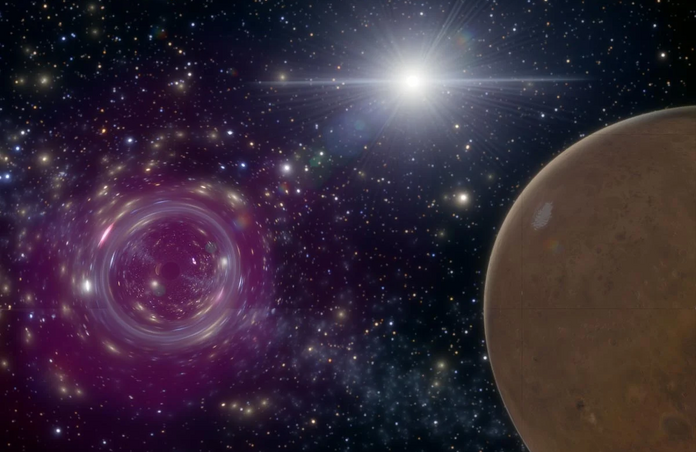Potential dark matter detection through deviation in mars orbit

It has been proposed by MIT physicists that if most of the dark matter in the universe is incorporated into microscopic primordial black holes, these should race through our solar system at least once per decade at velocities of 7000 times the speed of sound. If this is true, a detection of this kind would provide evidence in support of the notion that primordial black holes are a primary source of dark matter throughout the universe.
Under 20% of the universe is ordinary matter, with the rest comprising dark matter. The existence of this dark matter is only known through the gravitational interactions it has with stars and galaxies, affecting their motion. However, it is invisible across the entire electromagnetic spectrum which makes it challenging to study. There have been a number of detectors built on earth in an attempt to spot dark matter and better understand its properties. These experiments assume that dark matter is in the form of exotic particles that could scatter and decay into an observable particle as it passes through a given detector. However, such efforts haven’t been successful.
More recently, an older concept from the 1970s has become an increasingly popular idea: instead of being in particle form, dark matter could be present as microscopic, primordial black holes that formed in the first moments after the big bang. Such black holes would have formed from the collapse of dense pockets of gas in the adolescent universe, scattering across space as the universe expanded and cooled.
Many of these miniature black holes would be as small as an atom but as heavy as the largest asteroids. If this were the case in reality, it would be possible for these objects to exert a gravitational force that could explain a portion of the dark matter. This posed the question: what would happen if one of these black holes passed through a human?
By doing a basic calculation, Tung Tran, a graduate student at Stanford University who was involved in the study found that if a microscopic black hole passed within 1 meter of a person, the force would push them 6 meters within a second. However, the probability of this happening was found to be extremely unlikely.
The team developed these calculations to investigate how a black hole flyby would affect larger bodies such as the earth and moon. "We extrapolated to see what would happen if a black hole flew by Earth and caused the moon to wobble a little bit," Tung says. "The numbers we got were not very clear. There are many other dynamics in the solar system that could act as some sort of friction to cause the wobble to dampen out." To study further, a simple simulation of the solar system was set up, including the orbits and gravitational interactions between all planets and some of the largest moons.
"State-of-the-art simulations of the solar system include more than a million objects, each of which has a tiny residual effect," Lehmann notes. "But even modeling two dozen objects in a careful simulation, we could see there was a real effect that we could dig into."
The rate at which a primordial black hole would travel through the system was calculated at 7000 times the speed of sound. This velocity depends on the amount of dark matter estimated within a given region of space and the mass of the black hole, assumed to be as massive as the larges solar system asteroids.
Various asteroid mass black holes racing through the solar system from a range of angles at velocities of around 150 miles per second were simulated. The directions and speeds were determined from previous studies of the distribution of dark matter in our galaxy. In particular, they focused on ‘close encounters’, or situations which caused some effect on surrounding objects. It was found that any effects on the earth or moon weren’t certain enough to be attributed to a particular black hole. However, the effect was much more noticeable on mars - if a primordial black hole passed within a few hundred million miles of mars, it would cause a wobble or deviation in mars’ orbit. After a few years, mars’ orbit should shift by around a meter, which is enough to be detected by the high precision instruments currently monitoring the martian planet.
If this wobble was detected in the coming decades, there would still be a lot of work to be done to confirm that the wobble was the result of a black hole instead of an asteroid. The team are currently considering a new collaboration with a group that have expertise in simulating a larger number of objects in the solar system.
--
Cover image: Benjamin Lehmann, via SpaceEngine @ Cosmographic Software LLC
Journal source: Tung X. Tran et al, Close encounters of the primordial kind: a new observable for primordial black holes as dark matter, Physical Review D (2024). journals.aps.org/prd/abstract/ … /PhysRevD.110.063533. On arXiv: arxiv.org/abs/2312.17217
